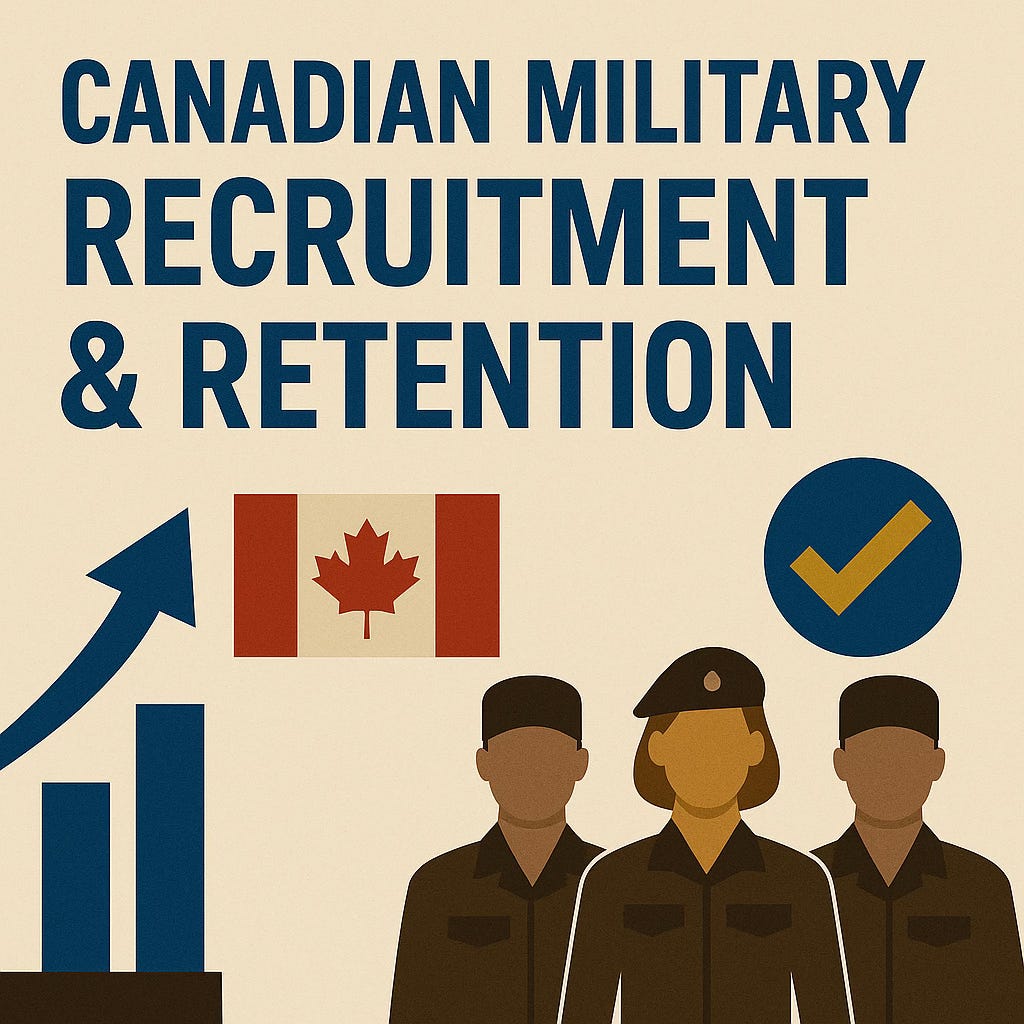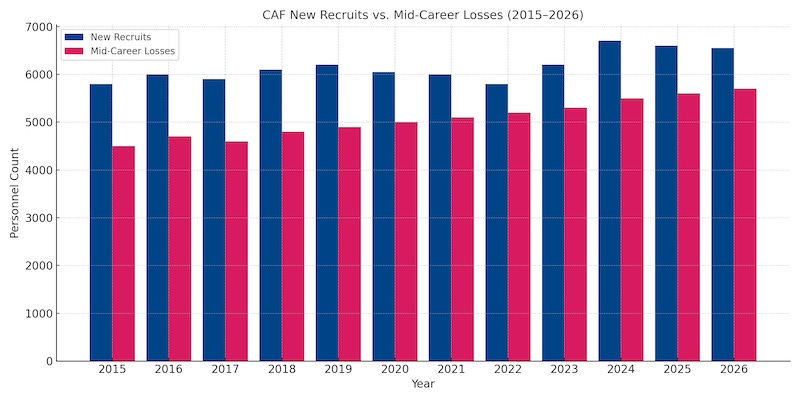Canada's Military: A New Era of Growth and Transformation
The Quiet Build-Up Part 4. Canada’s Military Can Lead by Evolving

Canada just hit a 10-year high in military recruitment. But behind the celebration lies a tougher truth: we’re filling the ranks, but losing our leaders.
For the first time in over a decade, the Canadian Armed Forces (CAF) exceeded its recruitment goals—welcoming 6,706 new regular force members in 2024–25, surpassing its target of 6,496 recruits. The 55% year-over-year increase is an undeniable success. It marks a clear shift after years of stagnation, and reflects renewed federal focus on rebuilding Canada’s military capacity.
This surge aligns with Ottawa’s broader strategic pivot. With a $9.3 billion boost in defence spending, an accelerated plan to meet NATO’s 2% GDP target, and a new national security posture emphasizing sovereignty, Canada is reasserting its place on the global stage.
As Minister of National Defence David McGuinty said on “It’s Political” with Althia Raj (June 2025)
"We are an Arctic country. We are a Pacific country. We are an Atlantic country. We need to be able to discharge our responsibilities here for 40 million people."
But building a modern force isn’t just about bringing new people in. It’s about keeping them.
Retention: The Real Test of Readiness
Every new recruit represents a significant investment. According to the Department of National Defence, it costs an estimated $2 million to recruit and train a single service member. That number can rise to $6 million by the time they reach mid-career, thanks to advanced training and development.
Yet retention has remained stubbornly low. Since at least 2010, the CAF has faced an annual attrition rate of around 8%. That means while thousands enter, thousands also quietly exit—often mid-career, taking with them leadership, experience, and institutional knowledge. These aren’t just individual losses. They’re systemic capability gaps.
The good news? We know exactly where to focus to turn those numbers around.
Representation Matters: Building a Force That Reflects Canada
Another concern lies in who is staying—and who is missing. Women currently make up just 16.6% of the CAF, and their representation in leadership and combat roles is significantly lower. Despite combat roles being opened to women in 1989, they continue to account for only about 5% in these areas.
The CAF’s stated goal is 25% female representation by 2026. It’s ambitious—but achievable if backed by real change. Countries like Norway and New Zealand have demonstrated that inclusion, when prioritized and properly resourced, yields not only fairness—but operational effectiveness.
Culture Change or Crisis Management?
Retention, especially among women and marginalized groups, is inextricably linked to culture. The 2022 Arbour Report on Sexual Misconduct laid bare the scale of the problem:
67% of CAF members reported witnessing or experiencing sexualized behaviour.
7.5% of women reported sexual assault in the past year.
Over 80% of survivors chose not to report incidents, fearing reprisal or inaction.
This is a trust crisis—and it won’t be solved by policies alone.
Real change requires credible leadership, visible accountability, and a culture where safety and respect are non-negotiable. If the CAF cannot ensure these basics, recruitment successes will remain hollow.
Still, the first steps toward rebuilding that trust are visible. And that matters.
Reforms in Motion: What’s Being Done
There is movement. Military leadership has introduced several initiatives aimed at both reform and renewal:
IDEaS Gender-Focused Recruitment Challenge: Up to $1.2 million in support for projects focused on recruiting and retaining women in underrepresented roles.
2024–29 Diversity & Inclusion Implementation Plan: A five-year roadmap to transform culture, improve leadership trust, and embed equity.
Chief of Professional Conduct and Culture (CPCC): A dedicated office to oversee misconduct prevention, policy reform, and culture change implementation.
But gaps remain. Nearly 50% of CAF women are still concentrated in a few occupations—admin, logistics, HR, and nursing. Leadership remains male-dominated, with only 10.1% of General Officers identifying as women. Until safety and career mobility improve, retention will lag.
And yet, the mechanisms for change are now on the table. That’s more than can be said for the past decade.
Meeting Basic Needs: Gear, Housing, and Dignity
Minister McGuinty emphasized the need for basic respect:
“Making sure that the folks who are serving get the kit they deserve and need, get the housing they deserve and need… women have uniforms that actually fit.”
It sounds simple. But years of substandard housing, outdated gear, and poorly tailored uniforms send a demoralizing signal: that service members' needs are an afterthought. You can recruit for the future—but if the conditions resemble the past, people won’t stay.
Addressing these tangible needs is one of the fastest, clearest ways to show the Forces—and the public—that change is real.
Rearming While Rebuilding: The Bigger Picture
The government now argues that defence should be treated as a core industrial sector—like energy or housing. That shift would:
Boost domestic manufacturing
Create long-term, skilled jobs
Strengthen Canada’s role in allied supply chains
As McGuinty noted:
“We can do good with our Canadian Armed Forces while doing well economically.”
In short: Defence isn’t just a cost. It’s an investment in sovereignty, resilience, and national prosperity.
This is the kind of systems thinking that signals real transformation.
The Takeaway: Retention Is Readiness
Meeting the intake target is a milestone worth celebrating—but it’s just the beginning. If today’s recruits become tomorrow’s mid-career exits, we’re back at square one.
Real readiness won’t be measured by numbers on a sign-up sheet. It will be measured by:
Who stays
Who leads
Who thrives in uniform
And whether the CAF becomes a place that Canadians can serve with pride and safety—for the long haul.
To make that happen, the focus must shift. Retention—not just recruitment—must become the primary metric of success. Leadership must report not only to Parliament, but through it, to the Canadians footing the bill.
Canada has an opportunity not just to rebuild, but to reimagine what service looks like—and who sees themselves in it. The right choices now can deliver a military that’s modern, resilient, and unmistakably Canadian.
That’s not just hope. That’s strategy.
🔗 Explore the Quiet Build-Up Series:
Part 1: Why Canada Joining Europe’s Rearmament Plan Is a Strategic Power Move
Part 2: The Quiet Build-Up, Part 2: The 2% Myth
Part 3: The Quiet Build-Up 3, CAF Fighter Jets
🧭 Like where this is going? Subscribe for more grounded, hopeful, and fiercely realistic reporting on Canada’s defence, democracy, and direction.
💬 If this gave you something to think about, please tap the 💚 or leave a comment below. Your voice matters here too—and it helps the algorithm know this conversation counts.




